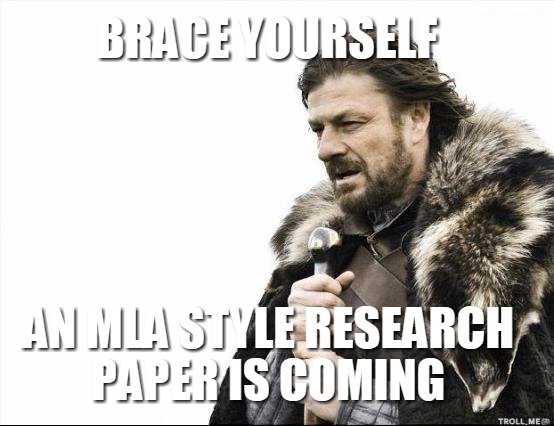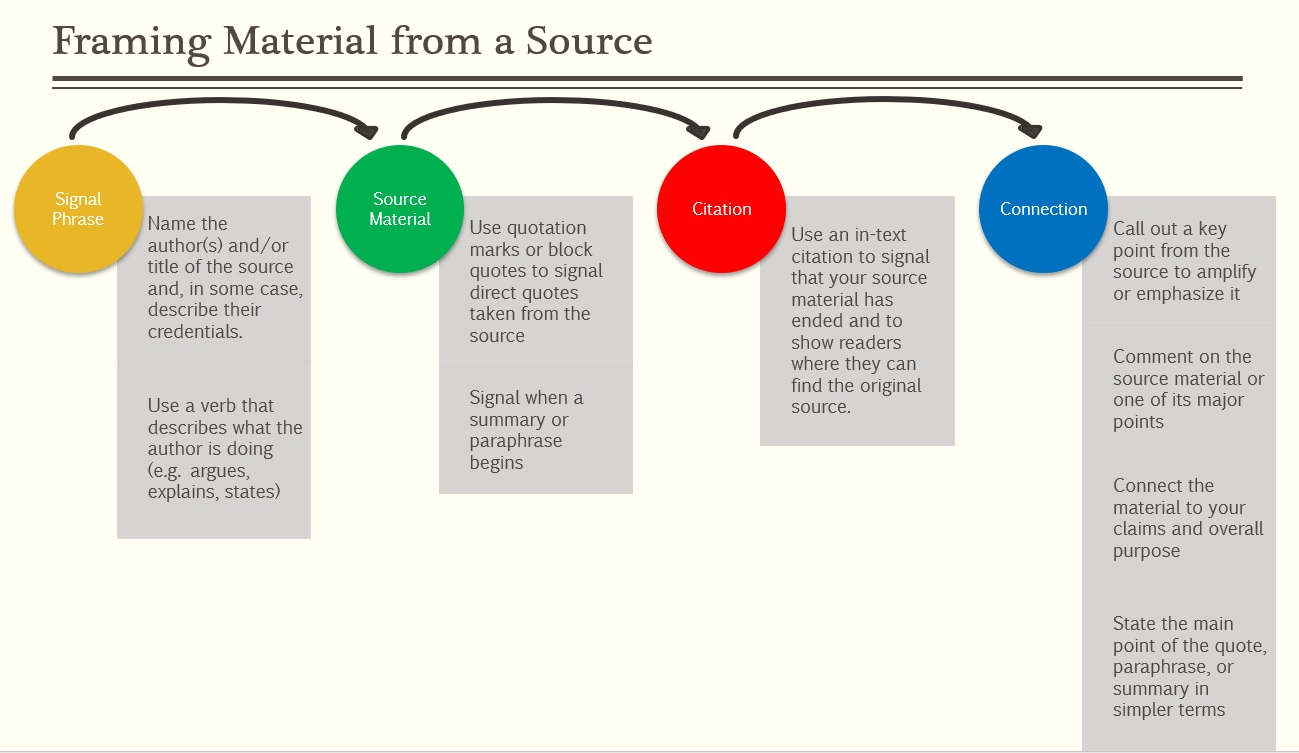24
By the end of this chapter, you will be able to:
- Directly quote from sources. (GEO 2; SLO 2, 5)
- Paraphrase and summarize source information. (GEO 2; SLO 2, 5)
Quotations
Short Quotes
Short direct quotations include prose (aka everyday language) that is no more than four lines. Save yourself a lot of headaches by sticking to short quotes (more to come on long quotes).
- Enclose what you are borrowing, word for word, from the source in quotation marks. “A blizzard occurs when you can’t see for 1/4 mile. The winds are always 35 miles an hour or more. The storm must last at least 3 hours to be classed as a blizzard” (SnowBrains).
- Include the in-text citation (aka parenthetical reference).
- Place questions marks or exclamation points that are part of the quote inside the quotation marks; place them outside of the quotation marks if they are not part of the author’s original words. Example: Andrews asked, “What was the principal aim of the revolution?” vs. Can you believe she called them “filthy traitors”?
- Include the complete citation for the source on the Works Cited page.
Long Quotes
For quotations that are more than four lines of prose, create a blockquote:
- Introduce the long quotes with a signal phrase and end it with a colon, unless the beginning of the long quote is a continuation of the sentence.
- Start the quotation on a new line.
- Capitalize the first word of the quotation, unless the quotation does not start with a complete sentence.
- Indent the entire quote one inch from the left margin (press tab twice).
- Do not use quotation marks around the quote (Yes, I know, this goes against everything you’ve learned about plagiarizing).
- Maintain double-spacing.
- The parenthetical reference should come after the closing punctuation mark.
Example
At the conclusion of Lord of the Flies, Ralph realizes the horror of his actions:
He is overcome by great, shuddering spasms of grief that seemed to wrench his whole body. His voice rose under the black smoke before the burning wreckage of the island; and infected by that emotion, the other little boys began to shake and sob too. (Golding 186)
Technical Aspects of Quoting
1. Commas:
Use a comma when you introduce a quote with a word like “said” (e.g. claims, observed, argues, etc.). You do not need to add a comma before or after a quote unless the sentence requires it.
Example
2. Brackets:
If you add a word or words in a quotation, you should put brackets around the words to indicate that they are not part of the original text. Use brackets to make grammatical sense of your words blended with the quote or use brackets to clarify something to the reader.
Example
3. Ellipses:
If you omit a word or words from a quotation, you should indicate the deleted word or words by using an ellipsis, which is three periods (. . . ) which are each preceded and followed by a space. What is left should make grammatical sense. Ellipsis marks are extremely useful in helping you to avoid long quotes.
Example
4. Single Quotation Marks:
Use single quotation marks only to mark quotes within quotes. A quote within a quote occurs when the material being quoted is already in quotation marks in the original source. Dialogue is not considered a quotation within a quotation.
Example
5. Capitalization:
Capitalize the first word of the direct quote if 1) it is a proper noun or 2) what you are quoting is a complete sentence.
6. Mistakes:
When quoting a grammatical error or misspelling, leave it be— YES, seriously. Instead, insert the word sic in italics directly after the mistake. Enclose it in brackets.
Example
7. Quoted In:
Sometimes you may have to quote something that has already been quoted in the source you are using. In this case, use “qtd. in” to indicate the source you consulted.
Example
8. Common Knowledge:
Common knowledge is a fact that is so well known that it can be found in numerous sources (at least 5 credible sources) and therefore, does not need to be cited. For example:
- Generally accepted facts: Pollution is bad for the environment.
- Facts that can be easily verified: President Obama was the 44th U.S. President.
- Common sayings or clichés: The grass isn’t always greener on the other side.
Note that not all facts are common knowledge and would still need to be cited, such as facts that include statistics or other numbers.
Example
Still cite information if you use the exact words of another writer, even if the content within could be considered common knowledge.
Example

Chop, Blend, and Digest Quotes
1. Chop:
Quote as concisely as possible. Reduce the quotation to just those bits you need to prove the point you’re making. You can quote as little as a single word!
Whatever you do quote needs to be exactly the same as the original. Misquoting is considered plagiarism. Yikes!
Only directly quote when it is the beauty of the language you are trying to capture or it is something that cannot be reworded; paraphrase if it is not.
2. Blend:
Introduce the quote with details that help the reader understand the quote’s context and significance (who said it, specifically? when? from what source? in what context?). You can also use signal phrases to blend quotes (see the left sidebar).
No direct quote can stand alone. Free-standing quotes are often called “Floating Quotes” or “Dropped Quotes”.
Examples
Example (incorrect): “Holden gets frustrated and decides to leave. “People are always ruining things for you” (Salinger 88).
Example (correct): Holden gets frustrated and decides to leave, claiming that “people are always ruining things for you” (Salinger 88).
3. Digest:
Make sure to prove how your quote proves your claim before moving on.
Example
Augustus and Hazel begin to spend more time together, and Gus makes an effort to get to know Hazel better by asking her what her story is. Disappointed with her answer, he responds, “Don’t tell me you’re one of those people who becomes their disease” (Green 70). Unfortunately, Hazel is one of those people but for a selfless reason; she fears that she will only hurt others with her imminent death.
Notice that in the above example, the writer left out Hazel’s response; what is important is Gus’s statement.
Paraphrases
When paraphrasing and summarizing, you are putting someone else’s ideas into your own words. In some situations, using a paraphrase or summary is preferable to using a quote. Using too many quotations can make a text look choppy and might lead the reader to think that you are just stitching together passages from other people’s works. Paraphrasing allows you to maintain the tone and flow of your writing.
To paraphrase means to take a piece of text- aka someone else’s ideas, opinions, examples, etc.-and put it in your own words. When you paraphrase, you do not leave any details out. In fact, paraphrases are often longer than the original piece of text! Attribution stills needs to be given to the author because the idea behind the paraphrase is not yours. Include an in-text citation with the author’s last name and page number. Generally, paraphrasing is better than directly quoting!
How to Paraphrase:
- Read and reread the text for understanding.
- Put the source away.
- Write key points that you remember without looking at the source. You do not even want to use the same sentence format or structure. Generally, you are not going to paraphrase a whole text — just a specific part of the text important to your essay or speech.
- Compare the paraphrase to the original to make sure you did not miss any key information OR plagiarize by including unique words.
- Quote any exact borrowings. Maybe it is just one unique word—put quotation marks around those borrowed words if you cannot come up with your own or you think the original is essential.
- Record the source on your Works Cited page.
Paraphrase Example
Original text: “Dogs are not colorblind. They are able to detect color in their vision, just not as vividly as humans” (“Dog Facts”). Source: AnimalPlanet.com
Unacceptable paraphrase: Contrary to popular belief, dogs are not colorblind. They are able to notice color, simply not as brightly as humans (“Dog Facts”).
Acceptable paraphrase: Colorblindness, according to AnimalPlanet.com, is not an adequate word to describe a dog’s eyesight. In fact, dogs are able to perceive the same colors as humans but only, in a more dull manner (“Dog Facts”).
Summaries
A summary is a shortened version of the original text that gives an overview of the main points. It should be written from a third-person point of view and in your own words. It needs to be clear to someone who hasn’t read the original text. The main points you present should follow (in most cases) the same order as the original text. It should include attribution to the author and include the title of the original text (if they have not already been stated in the essay). Use formal language for summaries. Lastly, remember to include a complete entry for the source on your Works Cited.
A summary does not contain your personal opinions and ideas. You must be objective and present only the author’s points, even if you disagree. Summaries should not use direct quotes (in most cases). Summaries should not use specific details such as percentages, numerical data, examples, interpretations, dates, figures.
Summary Writing Methods
 Read all texts through one time before highlighting anything. This way you can ask yourself when you are done “What is the one main point the author wants me to understand?”
Read all texts through one time before highlighting anything. This way you can ask yourself when you are done “What is the one main point the author wants me to understand?”
Fiction Method of Summarization
Use the formula “Somebody… Wanted …But… So… Then…” adding detail to your sentences as you go.
Nonfiction Methods of Summarization
IPOP: Important Points Only Please. Read the text highlighting the main points. Main points are typically found at the beginning of paragraphs. Remember to leave out specifics.
Heuristics (Who, What, When, Where, Why, and How): Read the text highlighting all of these elements. However, sometimes these elements are implied and not directly stated.
Section-by-Section: Summarize each sub-section of the text in a few words or a sentence. At each subsection weave the previous summaries into the current summary.
Why summarize if you can directly quote?
There are three basic reasons why it is important to summarize:
- Directly quoting limits your learning. By summarize the main ideas into your own words, you are going to understand the information better. As an added bonus, your teacher will like your essay more.
- The original text was not written for the same audience you are writing for. Changes need to be made.
- It helps in avoiding plagiarism.
Differences Between Paraphrasing and Summarizing
- A paraphrase handles only a portion of the original text, while a summary often covers its entire content.
- A paraphrase usually follows the organization of the original source, while a summary reorganizes the content to highlight the major points.
- A paraphrase is usually about the same length or a little shorter than the original text.
- A paraphrase looks through the text to convey what the author is saying, but summaries can also look at the text to explore an author’s strategies, style, reasoning, and other choices.
Framing Quotes, Paraphrases, and Summaries
Whether you use a direct quotation, a summary, or a paraphrase, it is important to distinguish the original source from your ideas and to explain how the cited source fits into your argument. While the use of quotation marks or parenthetical citations tells your reader that these are not your own words or ideas, you should follow the quote with a description, in your own terms, of what the quote says and why it is relevant to the purpose of your paper. You should not let quoted or paraphrased text stand alone in your paper, but rather, should integrate the sources into your argument by providing context and explanations about how each source supports your argument.
Sources that are not properly integrated into your paper are like “bricks without mortar: you have the essential substance, but there’s nothing to hold it together, rendering the whole thing formless,” as Matt Smith wrote in “Putting It All Together: Thesis Synthesis.”
Your readers need to see the boundaries between your work and the material you are using from your sources. To help your readers identify these boundaries, you should frame your quotations, paraphrases, and summaries by using signal phrases, citing sources, and making connections to your own writing. Refer to Chapter 14: Integrating Source Material for more information on framing source material.
- Signal Phrase: A signal phrase indicates where the source material comes from. The words “as” and “in” are often at the heart of a signal phrase (e.g. “As Gladwell argues,” “In his article, Gladwell states”).
- Source Material: If you are directly quoting a source, this information should be separated from your own words with quotation marks to differentiate which words came from the source and which are your own.
- Citation: An in-text citation directs your readers to the original source. In MLA Style, a parenthetical reference is used to cite the source.
- Connection: When you connect the source’s ideas to your own, you will make it clear how the source material fits in with your own statements and claims.

A group of words taken from a text or speech and repeated by someone other than the original author or speaker, noted with quotation marks.
The brief form of a source reference that included the text of an essay.
A citation style in which partial citations that reference a bibliographical citation are enclosed within parentheses and embedded in the text, either within or after a sentence.
In MLA Style, the bibliography (list of sources used) is referred to as the Works Cited page.
In MLA Style, a method of formatting long quotations of three lines or more.
Information that is widely known, easily verified, and not attributed to a person or entity. Common Knowledge does not need to be cited.
Source information expressed in the writer/researcher's own words, usually to achieve greater clarity.
A brief statement or account of the main points of a source, written by the writer/researcher.
A discovery tool that helps you ask insightful questions or follow a specific pattern of thinking.

